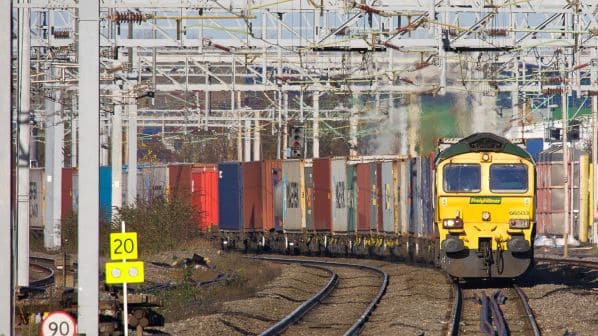BRITAIN’s Railway Industry Association (RIA) has welcomed a report from the Chartered Institute of Logistics and Transport’s (Cilt), which says only 1287km of additional electrification is needed to enable 95% of rail freight to be electrically hauled. The initial 96.5km of infill electrification is estimated to cost around £50m per annum over two years.
Currently, only 10% of British freight trains are hauled by electric locomotives and Britain lags behind its European counterparts when it comes to rail freight electrification.
The strategy was released the same day as the Transport Select Committee’s (TSC) new report, Fuelling the future: motive power and connectivity, which reiterated that while rail travel is a naturally low-carbon transport mode, trains in Britain still heavily rely on diesel traction.
In 2018, the government committed to phasing out all diesel-only trains by 2040, including freight trains. The report says that to achieve its decarbonisation goals, the government must electrify the network at a faster rate. The report also recognises that while battery electric and hydrogen may be a more cost-effective solution for some lines, neither is currently capable of providing the power needed for freight services. Indeed, biofuels may be the most viable option for decarbonising rail freight in the short and medium term.
“We reiterate a previous recommendation that the Department for Transport publish a long-term strategy for decarbonising the rail network, including a vision for what proportion of the future network will use electrification, battery and hydrogen, and a credible delivery plan,” the committee says.
Cilt’s electrification strategy suggests an electrification programme of 64 route-km per annum for 20 years, at a cost of £100m per year, is required to deliver the significant opportunity for Britain to meet its decarbonation and net-zero goals.
Based on detailed analysis of data on rail freight movements across Britain, the lines proposed for electrification lead from main container ports to inland distribution centres, which are key supply chain hubs, and from major quarries to urban areas.
The first phase would see electrification of the key cross-country line from Felixstowe to the Midlands and North avoiding London. This provides a direct link to the West Coast Main Line at Nuneaton for the northwest and Scotland and, along with the line from Peterborough via Lincoln to Doncaster, a direct link to Yorkshire and the northeast.
The next phase would electrify the link from Southampton, Britain’s third largest container port, to inland markets. The first stage involves electrification from Basingstoke to Reading and from Didcot, via East West Rail, to Bletchley on the West Coast Main Line. A second stage would see the route from Southampton to Basingstoke via Andover electrified.
The third phase involves lines from major quarries and cement works in the Peak District and the Mendips in Somerset. This would allow electric haulage of millions of tonnes of heavy construction materials a year to Manchester, Leeds, Birmingham and the southeast.
“Today’s reports by both the TSC and Cilt clearly show that rail is not on track to help the government achieve Net Zero by 2050,” says RIA technical director, Mr David Clarke. “Both the TSC’s report, which urges government ministers to go faster when it comes to electrification, and the Cilt’s roadmap, which sets out a plan to decarbonise 95% of rail freight by the mid-2040s, are helpful and timely.
“The TSC report is very clear that with just 38% of the rail network electrified and the government committed to removing all diesel-only trains by 2040, there needs to be a major acceleration of electrification on intensively-used lines and the ramping up of hydrogen and battery trains on other parts of the network.
“The Cilt roadmap shows how 128 million diesel HGV-km can be taken off Britain’s roads each year, as well as giving credible evidence that a rolling programme of freight electrification can be delivered at lower cost than recent schemes, building on RIA’s Electrification Cost Challenge report.”

